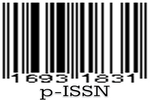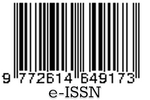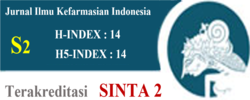Cocrystallization of curcumin–isonicotinamide with ultrasonic wave treatment to increase solubility
Abstract
Curcumin is a polyphenol compound with various biological activities, but its solubility in water is very low (4-8 µg/mL). This research aims to increase the solubility of curcumin through cocrystallization with isonicotinamide coformer. Cocrystallization was carried out using solvent evaporation, which was treated with ultrasonic waves. Cocrystal characterization was carried out using light microscopy, PXRD, DSC, and FTIR. The cocrystal solid was evaluated for solubility using the shaking method, while the dissolution test was carried out in a phosphate buffer medium, pH 6.8, with type II equipment. The results show that cocrystallization with ultrasonic wave treatment produces solid cocrystals (CICoc-Ult) with different solid properties than those without ultrasonic wave treatment (CICoc). CICoc-Ult showed higher solubility and dissolution compared to initial curcumin and CICoc cocrystals. Therefore, ultrasonic wave treatment in the cocrystallization process of curcumin using the solvent evaporation method can be used as a potential strategy to overcome the problem of the solubility properties of curcumin.
References
[2] R. Tabanelli, S. Brogi, and V. Calderone, "Improving curcumin bioavailability: Current strategies and future perspectives," Pharmaceutics, vol. 13, no. 10, p. 1715, Oct. 2021.
[3] Y. Peng, M. Ao, B. Dong, Y. Jiang, L. Yu, Z. Chen, et al., "Anti-inflammatory effects of curcumin in the inflammatory diseases: Status, limitations and countermeasures," Drug Des. Devel. Ther., vol. 15, pp. 4503–4525, Nov. 2021.
[4] K. Suresh and A. Nangia, "Curcumin: Pharmaceutical solids as a platform to improve solubility and bioavailability," CrystEngComm, vol. 20, no. 24, pp. 3277–3296, 2018.
[5] M. Karimi-Jafari, L. Padrela, G. M. Walker, and D. M. Croker, "Creating cocrystals: A review of pharmaceutical cocrystal preparation routes and applications," Cryst. Growth Des., vol. 18, no. 10, pp. 6370–6387, Oct. 2018.
[6] J. Haneef and R. Chadha, "Drug-drug multicomponent solid forms: Cocrystal, coamorphous and eutectic of three poorly soluble antihypertensive drugs using mechanochemical approach," AAPS PharmSciTech, vol. 18, no. 6, pp. 2279–2290, Jan. 2017.
[7] C. A. S. Bergström and P. Larsson, "Computational prediction of drug solubility in water-based systems: Qualitative and quantitative approaches used in the current drug discovery and development setting," Int. J. Pharm., vol. 540, no. 1–2, pp. 185–193, Apr. 2018.
[8] M. Guo, X. Sun, J. Chen, and T. Cai, "Pharmaceutical cocrystals: A review of preparations, physicochemical properties and applications," Acta Pharm. Sin. B, vol. 11, no. 8, pp. 2537–2564, Aug. 2021.
[9] K. Priyadarsini, "The chemistry of curcumin: From extraction to therapeutic agent," Molecules, vol. 19, no. 12, pp. 20091–20112, Dec. 2014.
[10] Y. He, H. Liu, W. Bian, Y. Liu, X. Liu, S. Ma, et al., "Molecular interactions for the curcumin-polymer complex with enhanced anti-inflammatory effects," Pharmaceutics, vol. 11, no. 9, p. 442, Sep. 2019.
[11] D. Yan, D. Bučar, A. Delori, B. Patel, G. O. Lloyd, W. Jones, et al., "Ultrasound-assisted construction of halogen-bonded nanosized cocrystals that exhibit thermosensitive luminescence," Chem.–Eur. J., vol. 19, no. 25, pp. 8213–8219, Apr. 2013.
[12] P. P. Apshingekar, S. Aher, A. L. Kelly, E. C. Brown, and A. Paradkar, "Synthesis of caffeine/maleic acid co-crystal by ultrasound-assisted slurry co-crystallization," J. Pharm. Sci., vol. 106, pp. 66–70, 2017.
[13] M. Rodrigues, J. Lopes, A. Guedes, J. Sarraguça, and M. Sarraguça, "Considerations on high-throughput cocrystals screening by ultrasound assisted cocrystallization and vibrational spectroscopy," Spectrochim. Acta A Mol. Biomol. Spectrosc., vol. 229, p. 117876, 2020.
[14] N. Pawar, A. Saha, N. Nandan, and J. V. Parambil, "Solution cocrystallization: A scalable approach for cocrystal production," Crystals, vol. 11, no. 3, pp. 303–303, Mar. 2021.
[15] I. Nugrahani, S. W. Komara, A. Horikawa, and H. Uekusa, "Composing novel diclofenac potassium and L-proline salt cocrystal as a strategy to increase solubility and dissolution," J. Pharm. Sci., vol. 109, no. 11, pp. 3423–3438, Nov. 2020.
[16] F. Alatas, N. Suwartiningsih, H. Ratih, and T. H. Sutarna, "Fluconazole-tartaric acid co-crystal formation and its mechanical properties," Pharm. Educ., vol. 21, no. 2, pp. 116–122, Jul. 2021.
[17] Y. Wicaksono, S. F. Tsaniyah, B. Wisudyaningsih, K. Z. Barikah, and L. O. R. K. Sari, "Preparation of atorvastatin calcium-dipicolinic acid multicomponent solids by liquid-assisted grinding method to increase solubility," Molekul, vol. 17, no. 3, p. 365, Nov. 2022.
[18] Y. Wicaksono, K. Z. Barikah, A. D. Yudatama, H. Maulia, N. Nuri, and D. Setyawan, "Increasing the solubility and anti-inflammatory activity of curcumin by cocrystallization," Sci. Technol. Indones., vol. 8, no. 3, pp. 501–508, Jul. 2023.
[19] M. Ishtiaq, S. Asghar, I. U. Khan, M. S. Iqbal, and S. H. Khalid, "Development of the amorphous solid dispersion of curcumin: A rational selection of polymers for enhanced solubility and dissolution," Crystals, vol. 12, no. 11, p. 1606, Nov. 2022.
[20] C. Fang, W. Tang, S. Wu, J. Wang, Z. Gao, and J. Gong, "Ultrasound-assisted intensified crystallization of L-glutamic acid: Crystal nucleation and polymorph transformation," Ultrason. Sonochem., vol. 68, p. 105227, Nov. 2020.
[21] S. K. Bhangu Kaur, M. Ashokkumar, and J. Lee, "Ultrasound assisted crystallization of paracetamol: Crystal size distribution and polymorph control," Cryst. Growth Des., vol. 16, no. 4, pp. 1934–1941, Mar. 2016.
[22] W. S. Kim, D. W. Kim, and K. K. Koo, "Effect of a surface-active agent on nucleation kinetics in ultrasound-assisted crystallization of paracetamol," J. Ind. Eng. Chem., vol. 77, pp. 441–448, Sep. 2019.
[23] P. Sanphui, N. R. Goud, U. B. R. Khandavilli, S. Bhanoth, and A. Nangia, "New polymorphs of curcumin," Chem. Commun., vol. 47, no. 17, p. 5013, 2011.
[24] H. Liu, H. Lin, Z. Zhou, and L. Li, "Bergenin-isonicotinamide (1:1) cocrystal with enhanced solubility and investigation of its solubility behavior," J. Drug Deliv. Sci. Technol., vol. 64, p. 102556, Aug. 2021.
[25] N. Rathi, A. Paradkar, and V. G. Gaikar, "Polymorphs of curcumin and its cocrystals with cinnamic acid," J. Pharm. Sci., vol. 108, no. 8, pp. 2505–2516, Mar. 2019.
[26] H. Wang, C. Zheng, F. Tian, Z. Xiao, Z. Sun, L. Lu, et al., "Improving the dissolution rate and bioavailability of curcumin via co-crystallization," Pharmaceuticals, vol. 17, no. 4, p. 489, Apr. 2024.
[27] M. Dhanasekaran, V. P. Sarvothaman, P. Guida, and W. L. Roberts, "Mechanistic insights into paracetamol crystallization: Exploring ultrasound and hydrodynamic cavitation with quartz crystal microbalance dissipation," ACS Eng. Au, Dec. 2024.
[28] J. Pantwalawalkar, H. More, D. Bhange, U. Patil, and N. Jadhav, "Novel curcumin ascorbic acid cocrystal for improved solubility," J. Drug Deliv. Sci. Technol., vol. 61, p. 102233, Feb. 2021.
[29] Y. Wicaksono, B. Wisudyaningsih, and T. A. Siswoyo, "Enhancement of solubility and dissolution rate of atorvastatin calcium by cocrystallization," Trop. J. Pharm. Res., vol. 16, no. 7, pp. 1497–1502, Aug. 2017.
[30] S. K. Abdul Mudalip, N. A. Sezali, and M. R. Abu Bakar, "Effect of ultrasonic waves on polymorphism and crystal size distributions of mefenamic acid," IOP Conf. Ser.: Mater. Sci. Eng., vol. 991, no. 1, p. 012118, Dec. 2020.
[31] X. Gong, A. Suryamiharja, and H. Zhou, "pH-induced structural changes of crystalline curcumin enhance its encapsulation in emulsions," ACS Food Sci. Technol., vol. 4, no. 12, pp. 2998–3006, Nov. 2024.
[32] S. Ozaki, Y. Nakagawa, O. Shirai, and K. Kano, "Substituent effect on the thermodynamic solubility of structural analogs: Relative contribution of crystal packing and hydration," J. Pharm. Sci., vol. 103, no. 11, pp. 3524–3531, Nov. 2014.
[33] R. Docherty, K. Pencheva, and Y. A. Abramov, "Low solubility in drug development: De-convoluting the relative importance of solvation and crystal packing," J. Pharm. Pharmacol., vol. 67, no. 6, pp. 847–856, Apr. 2015.
[34] J. Sun, F. Wang, Y. Sui, Z. She, W. Zhai, C. Wang, et al., "Effect of particle size on solubility, dissolution rate, and oral bioavailability: Evaluation using coenzyme Q10 as naked nanocrystals," Int. J. Nanomed., pp. 5733-5744, Nov. 2012.
[35] J. Li, X. Hao, C. Wang, H. Liu, L. Liu, X. He, et al., "Improving the solubility, dissolution, and bioavailability of metronidazole via cocrystallization with ethyl gallate," Pharmaceutics, vol. 13, no. 4, p. 546, Apr. 2021.
[36] Y. Wicaksono, V. A. Rosidi, S. Y. Saragih, L. S. Fauziah, and D. Setyawan, "Preparation of spray dried coamorphous solids to improve the solubility and dissolution rate of atorvastatin calcium," J. Teknol., vol. 83, no. 2, pp. 77–83, Feb. 2021.
[37] G. Sandri, M. C. Bonferoni, S. Rossi, C. M. Caramella, and F. Ferrari, "Effects of particle size, surface nature and crystal type on dissolution rate," AAPS Adv. Pharm. Sci. Ser., pp. 303–328, 2018.

This work is licensed under a Creative Commons Attribution-NonCommercial-ShareAlike 4.0 International License.
Licencing
All articles in Jurnal Ilmu Kefarmasian Indonesia are an open-access article, distributed under the terms of the Creative Commons Attribution-NonCommercial-ShareAlike 4.0 International License which permits unrestricted non-commercial used, distribution and reproduction in any medium.
This licence applies to Author(s) and Public Reader means that the users mays :
- SHARE:
copy and redistribute the article in any medium or format - ADAPT:
remix, transform, and build upon the article (eg.: to produce a new research work and, possibly, a new publication) - ALIKE:
If you remix, transform, or build upon the article, you must distribute your contributions under the same license as the original. - NO ADDITIONAL RESTRICTIONS:
You may not apply legal terms or technological measures that legally restrict others from doing anything the license permits.
It does however mean that when you use it you must:
- ATTRIBUTION: You must give appropriate credit to both the Author(s) and the journal, provide a link to the license, and indicate if changes were made. You may do so in any reasonable manner, but not in any way that suggests the licensor endorses you or your use.
You may not:
- NONCOMMERCIAL: You may not use the article for commercial purposes.
This work is licensed under a Creative Commons Attribution-NonCommercial-ShareAlike 4.0 International License.




 Tools
Tools





















